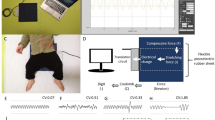Abstract
We present a noninvasive cardiopulmonary monitor for use in infants in which sensors are incorporated into conventional pajamas. It consists of dry electrodes for picking up the electrocardiogram and of two capacitive based elastic strain gauges for the measurement of thoracic and abdominal respiratory movements. The quality of the signals was assessed by performing at home seven sleep recordings in parallel with a conventional system and 16 overnight sleep recordings. In the former tests, the acquisition of all mean R–R intervals agreed in both systems with an accuracy of 15.6 ms, determined by the sampling frequency of the commercial system. For the overnight recordings, more than 99% of the R peaks were correctly detected. In 1.5%, both respiratory traces were simultaneously out of range. Finally, it was observed that more saturated episodes and less errors in R-peak detection appeared in prone than in supine position. In summary, these results demonstrated that the dry electrodes can be a good alternative to the sticking electrodes, and that this simple system is reliable. In contrast with the existing monitors, skin irritations are avoided, redundancy of respiratory signals is provided and user-friendliness of the system is reached. © 2003 Biomedical Engineering Society.
PAC2003: 8719Nn, 8780-y, 8719Uv
Similar content being viewed by others
REFERENCES
Bland, J. M., and D. G. Altman. Statistical methods for assessing agreement between two methods of clinical measurement. Lancet1:307–310, 1986.
Brouillette, R. T., A. S. Morrow, D. E. Weese-Mayer, and C. E. Hunt. Comparison of respiratory inductive plethysmography and thoracic impedance for apnea monitoring. J. Pediatr. (St. Louis)111:377–383, 1987.
Kohlendorfer, U., S. Kiechl, and W. Sperl. Sudden infant death syndrome: Risk factor profiles for distinct subgroups. Am. J. Epidemiol.147:960–968, 1998.
L'Hoir, M. P., A. C. Engelberts, G. T. van Well, T. Bajanowski, K. Helweg-Larsen, and J. Huber. Sudden unexpected death in infancy: Epidemiologically determined risk factors related to pathological classification. Acta Paediatr.87:1279–1287, 1998.
Pan, J., and W. J. Tompkins. A real-time QRS detection algorithm. IEEE Trans. Biomed. Eng.32:230–236, 1985.-
Author information
Authors and Affiliations
Rights and permissions
About this article
Cite this article
Gramse, V., De Groote, A. & Paiva, M. Novel Concept for a Noninvasive Cardiopulmonary Monitor for Infants: A Pair of Pajamas with an Integrated Sensor Module. Annals of Biomedical Engineering 31, 152–158 (2003). https://doi.org/10.1114/1.1540636
Issue Date:
DOI: https://doi.org/10.1114/1.1540636




